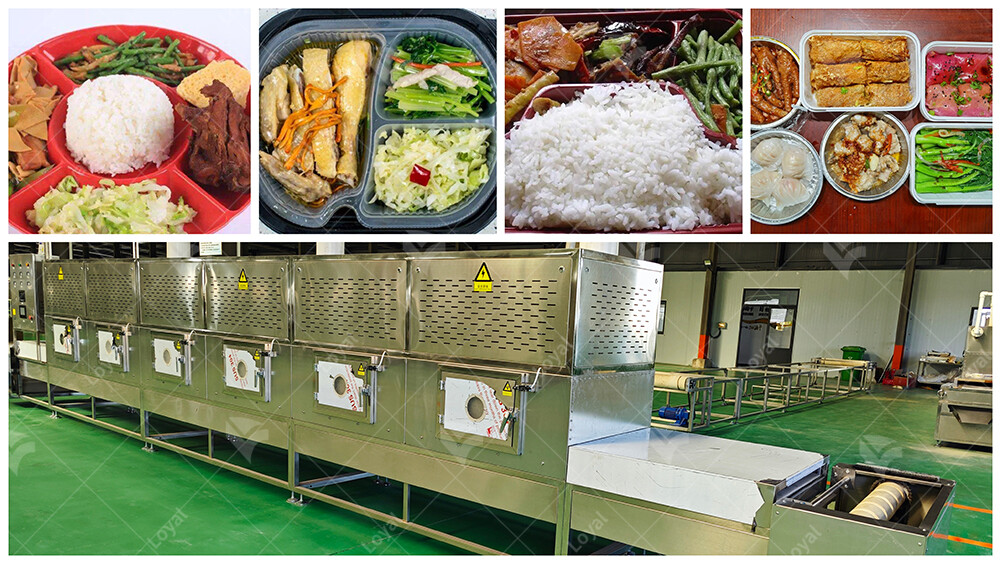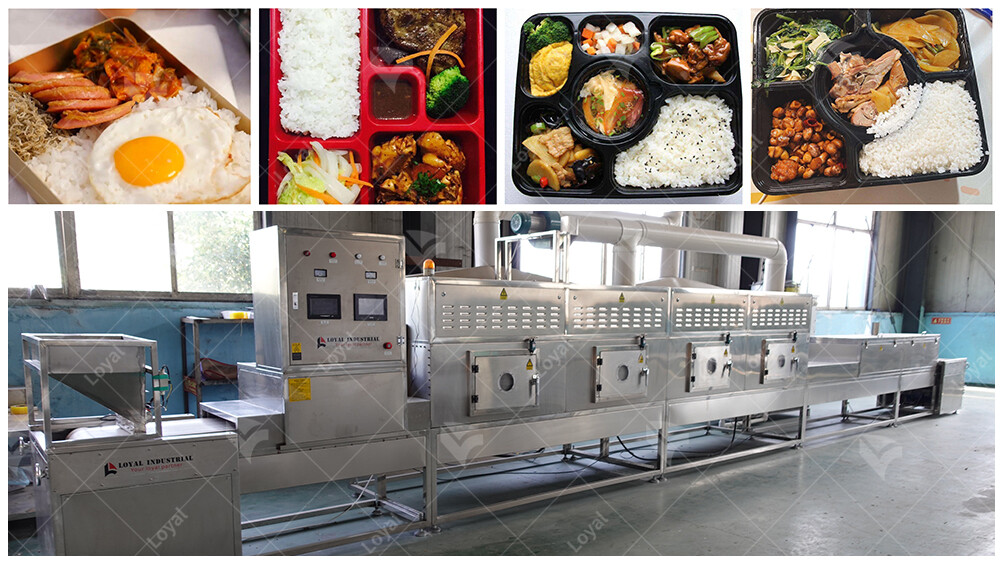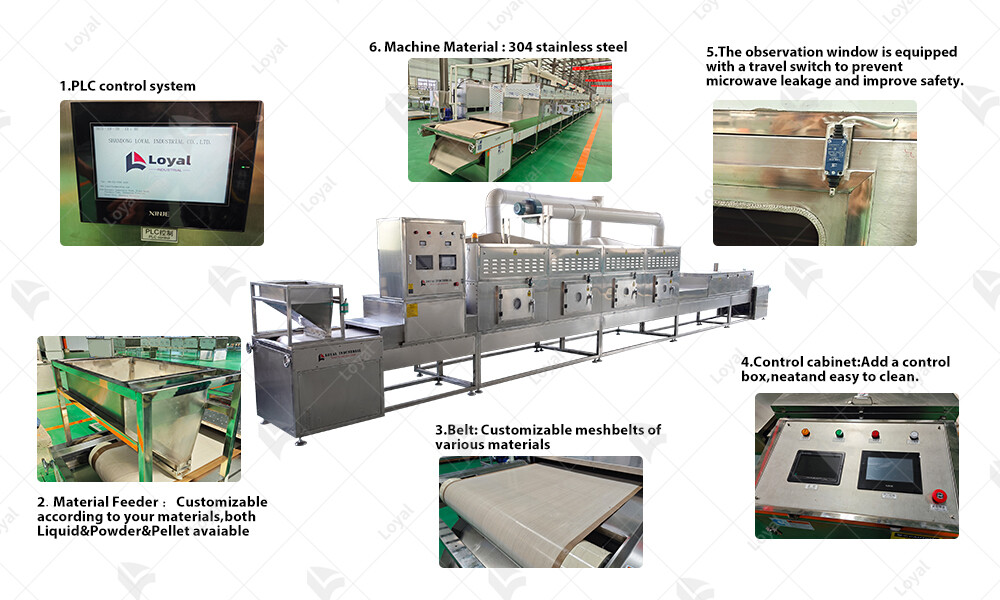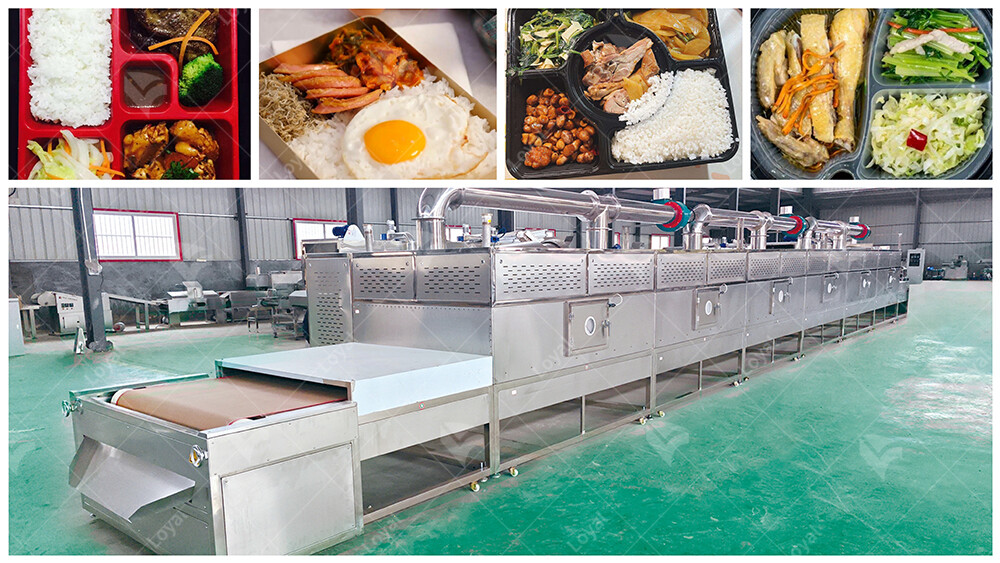Everything you Need to Know About Tunnel Microwave Fast Food Induction Heating Equipment
Introduction to Tunnel Microwave Fast Food Induction Heating Equipment
Tunnel microwave fast food induction heating equipment represents a cutting-edge solution in the fast food industry. Combining the efficiency of microwave technology with the precision of induction heating, these machines are revolutionizing the way fast food is prepared and served.
These systems feature a tunnel-like design, allowing fast food items to pass through a series of microwave and induction heating zones. As the food travels through the tunnel, it is exposed to electromagnetic waves generated by the microwave system, which penetrate deep into the food and rapidly heat it from the inside out. Simultaneously, induction heating elements located along the tunnel's walls provide additional heat to ensure thorough and uniform cooking.
The integration of microwave and induction heating technologies offers several advantages over traditional heating methods. Firstly, it significantly reduces cooking times, allowing fast food restaurants to serve more customers and increase throughput without sacrificing food quality. Additionally, the combination of microwave and induction heating results in more efficient energy utilization, leading to cost savings and environmental benefits.

Microwave Technology in Fast Food Industry
Microwave technology has become integral to the fast food industry, offering numerous benefits for food processing applications. From heating and cooking to thawing and drying, microwaves are widely used to streamline operations and improve efficiency in fast food establishments.
One of the key advantages of microwave technology is its ability to heat food rapidly and evenly. Unlike traditional heating methods such as convection or radiant heat, which rely on external heat sources, microwaves penetrate food directly and excite water molecules, generating heat from within. This results in faster cooking times and more consistent results, ensuring that fast food items are cooked thoroughly and evenly.
Moreover, microwave technology offers precise temperature control, allowing operators to tailor cooking parameters to achieve desired results for different types of fast food products. Whether it's reheating precooked items, cooking frozen foods, or preparing fresh ingredients, microwaves provide flexibility and versatility to meet diverse menu needs.
Additionally, microwaves are well-suited for fast food processing due to their compact size and ease of integration into existing production lines. Tunnel microwave fast food induction heating equipment, for example, can be seamlessly incorporated into conveyor belt systems, allowing for continuous and automated processing of food items with minimal manual intervention.
Furthermore, microwave technology offers energy efficiency advantages compared to traditional heating methods. Because microwaves heat food directly and do not require preheating or warm-up time, they consume less energy and reduce operating costs for fast food establishments. This not only contributes to cost savings but also aligns with sustainability goals by minimizing energy consumption and carbon emissions.

Benefits of Induction Heating in Food Equipment
Induction heating technology offers numerous benefits for food processing equipment, including tunnel microwave fast food induction heating equipment. Here are some key advantages:
1. Rapid Heating: Induction heating enables fast and efficient heating of food items, reducing cooking times and increasing throughput in fast food establishments.
2. Precise Temperature Control: Induction heating systems offer precise temperature control, allowing operators to achieve consistent cooking results for different types of food products.
3. Energy Efficiency: Compared to traditional heating methods, induction heating is more energy-efficient, resulting in lower operating costs and reduced environmental impact.
4. Uniform Heating: Induction heating ensures uniform heating throughout the food item, preventing overcooking or undercooking and ensuring consistent quality.
5. Versatility: Induction heating equipment can handle a wide range of food products, from meats and vegetables to baked goods and snacks, providing versatility and flexibility in fast food processing operations.
6. Safety: Induction heating systems are inherently safe, as they do not produce open flames or hot surfaces that could pose a risk to operators or food products.
7. Minimal Maintenance: Induction heating equipment requires minimal maintenance compared to traditional heating systems, reducing downtime and maintenance costs for fast food establishments.

Key Components of Tunnel Microwave Fast Food Induction Heating Machines
Tunnel microwave fast food induction heating machines consist of several essential components that work together to achieve efficient and uniform heating of fast food products.
One of the primary components is the microwave generator, which produces the electromagnetic waves used for heating. These generators are typically high-powered and designed to deliver precise levels of microwave energy to the food passing through the tunnel.
Another crucial component is the conveyor belt system, which transports fast food items through the heating tunnel. The conveyor belt is usually made of durable materials such as stainless steel and is designed to withstand high temperatures and heavy loads.
Tunnel microwave fast food induction heating machines feature an induction heating system. This system uses electromagnetic induction to generate heat directly within the food product, complementing the microwave heating process. Induction heating elements are strategically placed along the tunnel walls to provide additional heat and ensure thorough cooking.
These machines are equipped with temperature and moisture sensors to monitor and control the heating process. These sensors help maintain optimal cooking conditions and prevent overheating or undercooking of fast food items.

Operating Principles of Tunnel Microwave Fast Food Equipment
Tunnel microwave fast food equipment operates on the principles of microwave and induction heating to quickly and evenly heat a variety of fast food items.
The process begins with the loading of fast food products onto the conveyor belt, which carries them through the heating tunnel. As the food travels through the tunnel, it is exposed to electromagnetic waves generated by the microwave system.
These microwaves penetrate the food and excite water molecules, generating heat from within. This internal heating process ensures rapid and uniform cooking, resulting in consistent quality and flavor across all fast food items.
The induction heating system provides supplementary heat to further enhance the cooking process. Induction heating elements located along the tunnel walls generate electromagnetic fields that induce heat directly within the food product, contributing to faster cooking times and improved efficiency.
Throughout the heating process, temperature and moisture sensors continuously monitor the cooking environment to ensure optimal conditions. These sensors provide real-time feedback to the control system, allowing for precise adjustments to maintain consistent heating levels and prevent overcooking or undercooking.

Importance of Even Heating in Fast Food Processing
Even heating is crucial in fast food processing to ensure consistent quality, safety, and customer satisfaction.
Firstly, even heating helps prevent uneven cooking and hot spots, which can lead to foodborne illness or dissatisfaction among customers. By ensuring that all parts of the food product are heated uniformly, fast food establishments can minimize the risk of serving undercooked or overcooked items.
Moreover, even heating is essential for maintaining food quality and texture. Inconsistent heating can result in uneven textures and flavors, detracting from the overall dining experience. By achieving uniform heating, fast food processing equipment can deliver consistent quality and taste across all products.
Additionally, even heating contributes to energy efficiency and cost savings in fast food operations. By heating food evenly, less energy is wasted on overcooking or reheating unevenly cooked items. This not only reduces utility costs but also helps minimize food waste and improve overall operational efficiency.
Even heating plays a crucial role in food safety and compliance with regulatory standards. Properly heated food eliminates harmful bacteria and pathogens, reducing the risk of foodborne illness outbreaks and ensuring compliance with health and safety regulations.

Versatility in Menu Options with Tunnel Microwave Equipment
Tunnel microwave fast food induction heating equipment offers remarkable versatility in menu options, catering to the diverse needs of fast food establishments. These machines are designed to accommodate a wide range of food items, providing flexibility and efficiency in fast food preparation.
One of the key advantages of tunnel microwave equipment is its ability to handle various types of food products simultaneously. Whether it's burgers, fries, chicken nuggets, or sandwiches, these machines can efficiently heat and cook different items at the same time, maximizing throughput and minimizing wait times for customers.
Tunnel microwave equipment allows for customizable cooking profiles, enabling fast food operators to adjust heating parameters to suit specific menu items. Whether it requires gentle heating to preserve moisture or high-temperature roasting for a crispy texture, these machines offer precise control over cooking conditions to ensure consistent results every time.
Tunnel microwave equipment is ideal for accommodating dietary preferences and restrictions, such as vegetarian, vegan, gluten-free, or allergen-free options. With the ability to quickly and efficiently prepare a variety of menu items, fast food operators can cater to a broader customer base and enhance their competitive edge in the market.

Safety Features in Tunnel Microwave Fast Food Machines
Safety is paramount in the design and operation of tunnel microwave fast food induction heating equipment, with numerous features implemented to ensure the well-being of operators and customers alike. These machines are equipped with advanced safety features to prevent accidents and minimize risks associated with high-temperature cooking processes.
One essential safety feature in tunnel microwave fast food machines is interlocking door systems, which prevent access to the microwave chamber during operation. This helps to protect operators from exposure to microwave radiation and hot surfaces, reducing the risk of burns or injuries.
Moreover, tunnel microwave equipment is equipped with temperature and humidity sensors to monitor cooking conditions and detect any anomalies that may indicate a malfunction or potential safety hazard. In the event of overheating or excessive moisture levels, the machine can automatically shut down or activate alarms to alert operators and prevent further escalation of the situation.
Tunnel microwave fast food machines are designed with robust construction and materials to withstand the rigors of commercial kitchen environments. Heat-resistant coatings, reinforced door seals, and durable components ensure reliable performance and minimize the risk of equipment failure or malfunction during operation.
Safety features play a crucial role in tunnel microwave fast food machines, ensuring the protection of operators, customers, and the surrounding environment. By adhering to stringent safety standards and implementing advanced safety features, these machines provide peace of mind and confidence in their operation.

Maintenance Requirements for Tunnel Microwave Fast Food Equipment
Proper maintenance of tunnel microwave fast food induction heating equipment is crucial to ensure continuous operation and prolong the lifespan of the equipment. Here are some essential maintenance requirements for maintaining tunnel microwave systems:
Firstly, regular cleaning of the equipment is essential to remove food residues, grease, and debris that may accumulate during operation. This includes cleaning the conveyor belt, microwave chamber, and other components using suitable cleaning agents and methods recommended by the manufacturer.
Secondly, inspection of critical components such as conveyor belts, bearings, and seals should be performed regularly to identify signs of wear or damage. Any worn or damaged parts should be replaced promptly to prevent equipment malfunction and downtime.
Lastly, safety inspections and tests should be performed regularly to identify and address potential safety hazards. This includes checking electrical connections, emergency stop mechanisms, and interlocks to ensure they are functioning correctly and comply with safety standards.
By following these maintenance requirements, operators can ensure the reliable operation of tunnel microwave fast food induction heating equipment, minimize downtime, and optimize production efficiency in fast food processing facilities.

Future Innovations and Trends in Microwave Fast Food Technology
The future of microwave fast food technology is marked by several exciting innovations and trends that promise to enhance efficiency, convenience, and sustainability in food processing and preparation.
One key trend is the development of advanced microwave heating systems with enhanced power and precision capabilities. These systems leverage cutting-edge technologies such as solid-state microwave generators and phased-array antennas to deliver precise and uniform heating, resulting in faster cooking times and improved product quality.
Another emerging trend is the use of sustainable materials and manufacturing processes in microwave fast food equipment. Manufacturers are exploring eco-friendly alternatives to traditional materials such as plastics and metals, as well as incorporating energy-efficient designs and components to reduce environmental impact.
Customization and personalization are becoming increasingly important in microwave fast food technology. Consumers are seeking personalized dining experiences tailored to their dietary preferences and nutritional needs, driving demand for customizable heating profiles and menu options in microwave fast food equipment.
Connectivity and remote monitoring capabilities are poised to transform the way microwave fast food equipment is operated and maintained. Cloud-based platforms and IoT (Internet of Things) technologies enable operators to monitor equipment performance, track energy usage, and receive real-time alerts and notifications, allowing for proactive maintenance and optimization of operations.
In conclusion, the future of microwave fast food technology is characterized by innovation, sustainability, and connectivity. By embracing these trends and advancements, manufacturers and food service operators can meet the evolving needs of consumers while improving efficiency, reducing environmental impact, and delivering exceptional dining experiences.

References
The following are five authoritative foreign literature websites in the field of industrial microwaves:
1. IEEE Xplore Digital Library
Website: [https://ieeexplore.ieee.org/]
2.ScienceDirect
Website: [https://www.sciencedirect.com/]
3. SpringerLink
Website: [https://link.springer.com/]
4. Wiley Online Library
Website: [https://onlinelibrary.wiley.com/]
5. PubMed
Website: [https://pubmed.ncbi.nlm.nih.gov/]
 Telephone :+86-531-55583139
Telephone :+86-531-55583139 WhatsApp :+86 13256674591
WhatsApp :+86 13256674591 Email :
Email :










